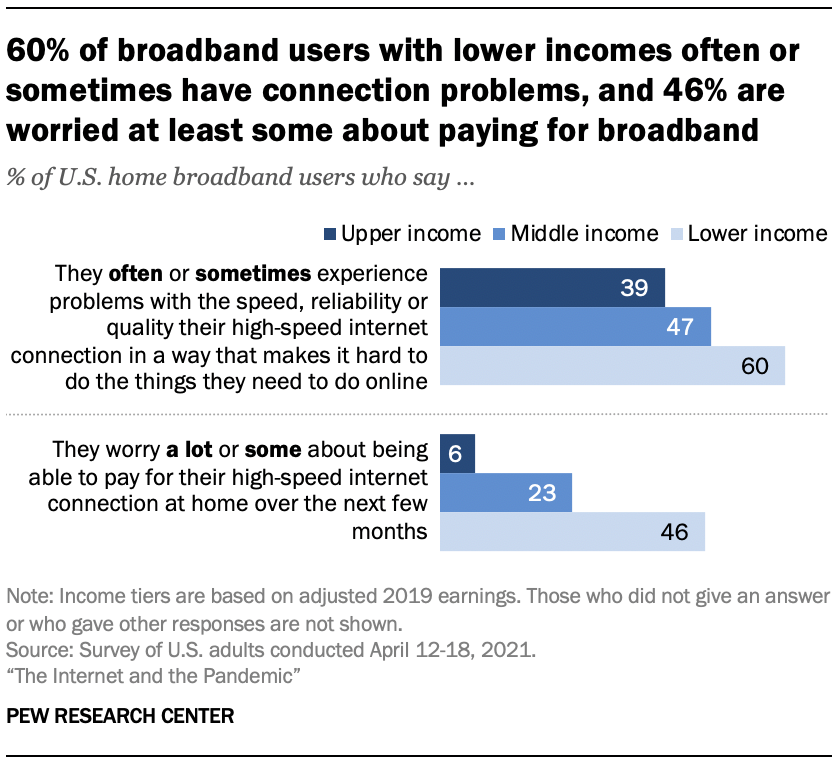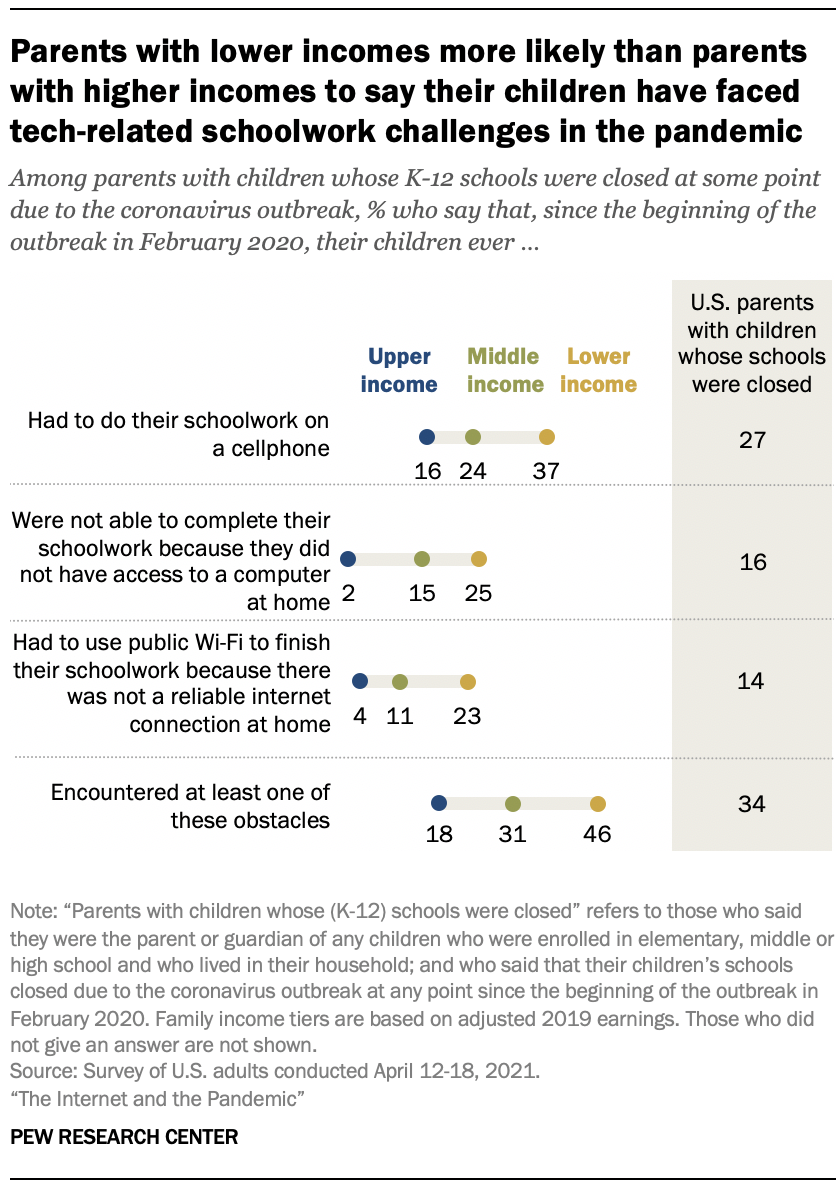How Americans Have Used — and Struggled With — the Internet During the Pandemic

Friday, September 10, 2021
Weekly Digest
How Americans Have Used — and Struggled With — the Internet During the Pandemic
You’re reading the Benton Institute for Broadband & Society’s Weekly Digest, a recap of the biggest (or most overlooked) broadband stories of the week. The digest is delivered via e-mail each Friday.
This week, guest authors Lee Rainie and Colleen McClain of Pew Research Center guide us through the results of a recent survey on how Americans have used the internet during the COVID-19 pandemic.
Round-Up for the Week of September 6-10, 2021

Last week, Pew Research Center released a sweeping report looking at how Americans have used the internet in the pandemic, how reliant they were on digital tools, and some of the struggles they have had as they tried to conduct many of the work-related, educational, social and community activities of their lives online.
The headlines from a survey of 4,623 adults from April 12-18, 2021 included:
- 90% of adults say the internet has been essential or important to them during the pandemic – and between April 2020 and April 2021 the share of those reporting the internet has been essential to them rose slightly from 53% to 58%.
- 40% of adults say they have used tech or the internet in ways new or different to them during the pandemic. A notable share of that new activity was video calling or conferencing for everything from work and school to essential tasks, connecting with friends and family or attending things like doctor’s appointments or church services. Overall, 81% of Americans reported ever talking with others via video call during the pandemic.
- 29% of broadband users did something to improve the speed, reliability or quality of their high-speed internet connection at home since the beginning of the outbreak.
The respondents who had done something new or different online during the pandemic were invited to describe these activities in open-ended answers and those answers highlighted how their online lives changed during the COVID-19 outbreak. Two illustrative quotes:
“I upgraded my internet (was just using a hotspot previously) and for my work, I am connected all day through the workday. If the internet goes down, my ability to work at home decreases significantly. Before the work from home started, if I lost the ability to connect to the internet, it only affected me in terms of annoyance at not being able to surf the net.” – Woman, 50
“I’ve gone from not even knowing remote programs like Zoom even existed, to using them nearly every day.” – Man, 54

Still, the survey found that people’s tech use has not been unqualifiedly great for everyone. The amount of effort some people made to stay connected took its toll. For instance, 40% of those who have ever talked with others via video calls since the beginning of the pandemic say they have felt worn out or fatigued often or sometimes by the time they spend on them. And the survey finds that a third of all adults say they tried to cut back on time spent on their smartphone or the internet at some point during the pandemic.

The pandemic also brought into focus some key digital divide issues:
- 48% of home broadband users say they have problems with the speed, reliability or quality of their home connection often or sometimes.
- 26% of home broadband users and 24% of smartphone owners said in the April 2021 survey that they worried a lot or some about paying their internet and cellphone bills over the next few months. And the numbers are more pronounced for those with lower incomes (see chart).
The “homework gap” was vividly evident, too. Nearly half of parents with lower incomes whose children faced school closures (46%) say their children had at least one problem related to the homework gap out of the three problems the Center queried in the survey: the children in those families had to do schoolwork on a cellphone, were unable to complete schoolwork because of lack of computer access at home, or had to use public Wi-Fi to finish schoolwork because there was no reliable connection at home.
Another dimension to the digital divide analysis the Center tackled in the survey involved issues related to concepts like “digital literacy.” We wanted to explore the degree to which people who might not feel comfortable as they use technology might have had different experiences and problems using tech during the COVID-19 pandemic.
We found that 26% of U.S. adults report that when they get a new computer, smartphone or other electronic device, they usually need someone else to set it up or show them how to use it. Relatedly, 10% say they are not at all or only a little confident using computers, smartphones or other electronic devices to do the things they need to do online. In total, 30% of Americans say either of these things, and our report considers them to have “lower tech readiness.”
 Older adults, as well as those with less formal education and less income were more likely than their counterparts to have “lower tech readiness.” This group also had different pandemic experiences. Those with lower tech readiness were:
Older adults, as well as those with less formal education and less income were more likely than their counterparts to have “lower tech readiness.” This group also had different pandemic experiences. Those with lower tech readiness were:
- Less likely than those with higher readiness to have said the internet has been essential during the pandemic.
- Less likely to have ever participated in video calls.
- Less likely to have found digital interactions a useful replacement for in-person contacts they might have otherwise had.
- More likely to report difficulty signing up for vaccines, among those who tried to sign up online.
- For parents whose children had some online instruction, those with “lower tech readiness” were more likely to have found it difficult to help their children with tech for online instruction.
To be sure, this survey was a snapshot of how Americans were using – and struggling with – technology during a portion of the pandemic era. Tech development and deployment will not stand still. Indeed, hundreds of experts canvassed by Pew Research said in the summer of 2020 that by 2025 the “new normal” would be more tech-driven and create a world where “tele-everything” would feel commonplace. Many of these experts expressed concerns about the inequities that would emerge in the next few years, the growing power of technology companies and unceasing spread of misinformation that can debilitate societies.
That seems reason enough to keep taking stock of how digital technologies are serving people now and those who have not fully reaped all the benefits.
Lee Rainie is the director of internet and technology research at Pew Research Center. Under his leadership, the Center has issued more than 650 reports based on its surveys that examine people’s online activities and the internet’s role in their lives.
Colleen McClain is a research associate focusing on internet and technology research at Pew Research Center.
Quick Bits
- NTIA Announces Over $5 Billion in Tribal Broadband Connectivity Program Funding Requests (NTIA)
- FCC Announces September Open Meeting Agenda (FCC)
- FCC Seeks Comment on Broadband Access in Multi-Tenant Buildings (FCC)
- First Nationwide Internet Connectivity Map that Links Broadband Serviceable Locations and Wi-Fi Access Points (LightBox)
- Texas governor signs bill prohibiting social media giants from blocking users based on viewpoint (Washington Post)
Weekend Reads (resist tl;dr)
- A Primer on Rural Broadband Deployment: A Q&A With Doug Dawson (Pew Charitable Trusts)
- Disconnected and Disregarded: Measuring Latinx Emergency Broadband Benefit Enrollment (National Hispanic Media Coalition)
- The federal government’s internet discount is slow to reach residents. These community leaders are offering a connection (Technically Media)
- What It’s Like to Be Underconnected to the Internet and Worried About Returning to Remote Learning (Slate)
- Who is Starlink really for? (MIT Technology Review)
- Closing the Digital Divide Requires an Expanded, Skilled Workforce (Broadband Communities Magazine)
ICYMI from Benton
- Democracy's Essential Infrastructure (Michael Copps)
- Consumer Reports: Millions of Americans Lack Fast Internet Service (James Willcox)
- Six Community Broadband Networks (Christopher Mitchell, Sean Gonsalves, Jericho Casper)
- Understanding Broadband Speed Data in NTIA’s Indicators of Broadband Need (Chris Ritzo, Lai Yi Ohlsen)
- The Emergency Broadband Benefit has thus far enrolled just 1 in 12 eligible households, but places with low broadband adoption rates show better results (John Horrigan)
- Our Challenge to Finally Close the Digital Divide (Robbie McBeath)
Upcoming Events
Sept 15—Tech Summit: At a Digital Crossroads (Politico)
Sept 17—National Tribal Broadband Summit (Department of Interior)
Sept 21—Spectrum Policy Symposium: Modernizing US Spectrum Strategy and Infrastructure (NTIA)
Sept 22—Connecting Minority Communities Pilot Program Webinar (NTIA)
Sept 22-24—49th Annual Research Conference on Communications, Information, and Internet Policy (TPRC)
Sept 23—Race and Digital Inequity: The Impact on Poor Communities of Color (Michelson 20MM Foundation)
Sept 23—IP3 Awards (Public Knowledge)
Sept 23—Connecting Minority Communities Pilot Program Webinar (NTIA)
Sept 24—National Tribal Broadband Summit (Department of Interior)
Sept 28—6G Summit on Connecting the Unconnected (Marconi Society)
Sept 30—September 2021 Open FCC Meeting
The Benton Institute for Broadband & Society is a non-profit organization dedicated to ensuring that all people in the U.S. have access to competitive, High-Performance Broadband regardless of where they live or who they are. We believe communication policy - rooted in the values of access, equity, and diversity - has the power to deliver new opportunities and strengthen communities.
© Benton Institute for Broadband & Society 2021. Redistribution of this email publication - both internally and externally - is encouraged if it includes this copyright statement.
For subscribe/unsubscribe info, please email headlinesATbentonDOTorg






